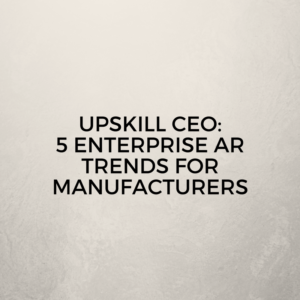5 Enterprise AR Trends for Manufacturers To Know

No. 1 – The world’s best-known brands will use enterprise AR to create and deliver their products and service their customers. Delivered via wearables like smart glasses, AR promises new levels of efficiency, service and quality that appears not only on the plant floor, but also throughout the entire supply chain. We are seeing large manufacturers moving beyond the pilot phase and adopting AR as part of a broader digital transformation strategy. In fact, PWC expects that 1 in 3 manufacturers will adopt AR/VR this year.
No. 2 – Service and logistics will driver broader AR adoption. Largely due to the intrinsic repeatability of their AR applications, field service and logistics are helping to move the market forward. This means that manufacturers should explore AR use cases involving their warehousing, material handling and equipment maintenance operations, where even a 10 percent efficiency gain can impact the bottom line or the ability to move production at a higher rate. For instance, workers can use AR on smart glasses to receive remote expert guidance during unplanned downtimes, or to attain step-by-step instructions during the picking process.
No. 3 – AR toolkits will simplify content creation. With the maturation of AR software development toolsets, there is a lower entry barrier for the knowledge required to build AR applications. Current toolkits offer drag-and-drop interfaces and templates, requiring little to no programming prowess. Between AR experiences being driven from Manufacturing Execution Systems and low/no-code authoring tools providing ways for designers and technicians to participate in the adoption and fine tuning of augmented reality, the time and complexity of adoption drops dramatically. With typically “non-technical” people creating new AR experiences, AR adoption will accelerate in the manufacturing realm and beyond.
No. 4 – Voice will be the primary AR interaction paradigm. The paradigm of Voice In, Image Out will be common in the age of AR. Gesture and touch AR interfaces aren’t exactly ideal for applications involving hands-on work, especially on the manufacturing plant floor. To keep workers free and nimble to perform their jobs, voice is emerging as the preferred method of AR interaction. We already see voice-powered smart assistants, like Amazon Alexa, gaining traction in consumer realm, so using voice in the enterprise is a natural trajectory, as many workers are already familiar with carrying out tasks using the technology.
No. 5 – Consumer AR investments will drive increased device options and experiences. There are many more exciting AR developments to come as adoption drives more investment into the tools and technology behind the AR industry. Behemoths like Google, Microsoft, Amazon, Apple and Facebook are unveiling new AR toolkits and decimation tools that will lead to an explosion of AR, VR and MR content. For manufacturers, the availability and accessibility of this content will raise the bar (and expectation) for how we engage with workers through rich, real-time information that enables them to complete their tasks faster and with greater quality. The sky will be the limit.
Looking back at these five trends, it is important to note the underlying theme: AR in manufacturing is all about the future of work. Despite today’s emphasis on automation and robotics, people will continue to play a pivotal role in hands-on work. AR will bridge the gap between man and machine, equipping workforces with right information, at the right time, and in an actionable manner. Trends such as new toolkits, new use cases, new interaction paradigms and new content will continue to accelerate AR adoption – empowering workers and laying the foundation for digital transformation across entire organizations.








